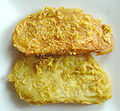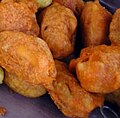 Carrot and chickpea fritters | |
| Main ingredients | Batter or dough |
|---|---|
| Ingredients generally used | Small pieces of meat, seafood, fruit, vegetables or other ingredients |
A fritter is a portion of meat, seafood, fruit, vegetables, or other ingredients which have been battered or breaded, or just a portion of dough without further ingredients, that is deep-fried. [1] [2] [3] [4] Fritters are prepared in both sweet and savory varieties. [4]
























